By Andrew Mulenga
+2nd+year+BA+Fine+Art+student+Rabecca+Mwanza.jpg) |
| 2nd year BA Fine Art student Rabecca Mwanza |
Since inception, the University of Zambia has had no room for the creative arts as an academic discipline and the country’s scholastic elite continue to look down upon the arts.
Fortunately, about three years ago, the privately owned Zambia Open University (ZAOU) introduced the School of Media, Performing and Fine Arts in an effort to afford individuals in the creative sector to attain professional qualifications at bachelor’s degree level.
Billy Nkunika, the school’s dean and one of only three members of staff who make up the faculty says the school’s operations have been able to progress through the years but it has not all been smooth sailing.
“We have three groups but only two lecturers, it can be quite stressful. But the encouraging thing is that you can see the enthusiasm in the students, our students are really trying to put in all the best under the circumstances” he says.
 |
| Lecturer William Miko guides a student |
Konica says apart from the challenge of material inputs, studio and theatre space for the students is an urgent requirement although there are silent plans by the universities administration to construct the same, it does not seem to be placed as a matter of priority. Currently, the art students borrow space at the Lusaka National Museum for two weeks of residential school once a year; this is the only time the students are in full, practical contact with their lecturers.
And Amanda Chabeba a first year Bachelor of Fine Arts student from Ndola who was in Lusaka for two weeks annual residential school says the course was interesting but too hectic because of the limited time that constitutes the nature of the distance learning progrmme.
“We have been given work to take home. We are back in June for exams and we will bring back the assignments that we have been given,” she says “But anyway I am still excited at the opportunity because I have been looking forward to studying for a degree in art ever since I graduated from Evelyn Hone College”.
Amanda, who teaches grades 8 and 9 at Dag Hammerskjoeld basic school in Ndola is disappointed however that art students are the most under rated at ZAOU. She observes that students in other disciplines took their residential school at the Copperbelt University, whereas the art students had to squat with friends and relatives for the duration of their residential school.
And Nickson Alitili a first year student who decided to take up art after reading several articles on contemporary art in the Weekend Post.
“The course is a blessing to me and it will go a long way in enhancing the passion that I have for the arts. But we still lack in certain areas, I thought the university will come in and help us with easels and other equipment, they really have to improve on the infrastructure”.
Nickson also explains that due to the distance learning nature of the programme, as first years they are totally detached from their seniors who go for residential school at different periods.
“There are times when you need advise on certain issue and can’t get it. Maybe if we could have some student’s blog, or a portal, that could help,” he says “I also think it would be good to have a residential school in the middle of the year not just exams”.
In addition, William Miko, the school’s only fine arts lecturer says introducing the programme is merely an attempt to “correct a national anomaly”.
“Why subsequent governments have not paid attention to establishing a school I cannot answer. As for the current government, they have pronounced the establishment of at least 6 universities so far,” he says “But I doubt if any of them will have a faculty of arts and culture to be at par with many universities surrounding us in the region”.
Miko says the distant learning method of the art school at ZAOU may be the school’s major challenge because art is a technical subject that requires what he describes as face to face or contact hours with students.
“We have students coming in from as far as Chiyengi, Kabompo, Solwezi and Livingstone, this should tell you how much people have been looking forward to such a programme in the country”, he says “In my own view this is something that has been a conspicuous missing element in the development of arts and culture in Zambia. That’s why it is perhaps reflective of the lip-service that government pays to the arts.”
He says because artists have not been developed to degree level they are not able to assert themselves at high level symposia on the international stage.
“When it comes to administration in talent-based institutions, the petty squabbles that you find in NAC or Football Association of Zambia (FAZ) you will not find them in Law Association of Zambia (LAZ) or Engineers Association of Zambia (EAZ) because they have minimum levels of education at degree level” declares Miko “You will find them scrounging for little allowances here and there, that’s because their thinking capacity hasn’t been expanded to the highest levels”
He is hopeful that the government will try and rectify the issue of arts administration as soon as possible.
“As it is now, even in the government ministerial structure the arts are still scattered everywhere, why? Because people at cabinet office don’t know that to do with the arts, and you cant blame them”
Miko also regrets the fact that Religious Education and Physical Education teachers with degrees have now been given the responsibilty of supervising and marking art examination papers and the sooner ZAOU can churn out teachers with degrees in arts the better, so that they can assume their rightful position in this regard.

No comments:
Post a Comment